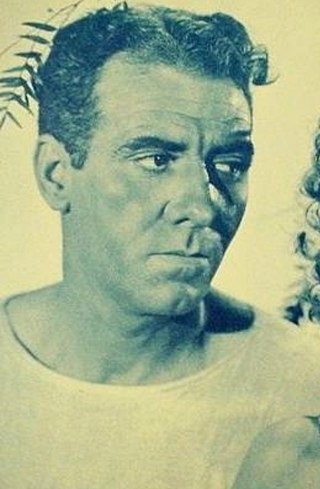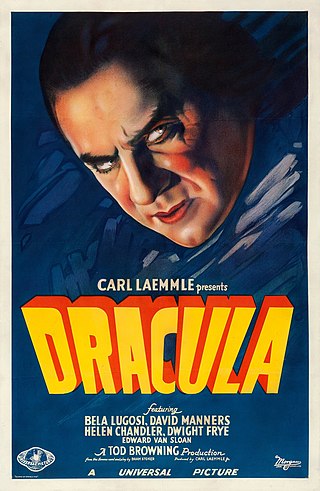Related Research Articles

Horror is a film genre that seeks to elicit fear or disgust in its audience for entertainment purposes.

William Henry Pratt, known professionally as Boris Karloff and occasionally billed as Karloff the Uncanny, was an English actor. His portrayal of Frankenstein's monster in the horror film Frankenstein (1931), his 82nd film, established him as a horror icon, and he reprised the role for the sequels Bride of Frankenstein (1935) and Son of Frankenstein (1939). He also appeared as Imhotep in The Mummy (1932), and voiced the Grinch in, as well as narrating, the animated television special of Dr. Seuss' How the Grinch Stole Christmas! (1966), which won him a Grammy Award.

Abbott and Costello were an American comedy duo composed of comedians Bud Abbott and Lou Costello, whose work in radio, film, and television made them the most popular comedy team of the 1940s and 1950s, and the highest-paid entertainers in the world during the Second World War. Their patter routine "Who's on First?" is considered one of the greatest comedy routines of all time, a version of which appears in their 1945 film The Naughty Nineties.

A ghost story is any piece of fiction, or drama, that includes a ghost, or simply takes as a premise the possibility of ghosts or characters' belief in them. The "ghost" may appear of its own accord or be summoned by magic. Linked to the ghost is the idea of a "haunting", where a supernatural entity is tied to a place, object or person. Ghost stories are commonly examples of ghostlore.
Supernatural fiction or supernaturalist fiction is a genre of speculative fiction that exploits or is centered on supernatural themes, often contradicting naturalist assumptions of the real world.

Japanese horror is horror fiction derived from popular culture in Japan, generally noted for its unique thematic and conventional treatment of the horror genre differing from the traditional Western representation of horror. Japanese horror tends to focus on psychological horror, tension building (suspense), and the supernatural, particularly involving ghosts (yūrei) and poltergeists. Other Japanese horror fiction contains themes of folk religion such as possession, exorcism, shamanism, precognition, and yōkai. Media in which the genre of Japanese horror fiction can be found include artwork, theater, literature, film, anime and video games.

Lionel Alfred William Atwill was an English and American stage and screen actor. He began his acting career at the Garrick Theatre. After coming to the United States, he appeared in Broadway plays and Hollywood films. Some of his more significant roles were in Captain Blood (1935), Son of Frankenstein (1939) and To Be or Not to Be (1942).

Frank Faylen was an American film and television actor. Largely a bit player and character actor, he occasionally played more fleshed-out supporting roles during his forty-two year acting career, during which he appeared in some 223 film and television productions, often without credit.

Elwood Bailey Bredell was an American cinematographer and child silent screen actor. He is sometimes credited as Woody Bredell or Elwood Dell. Although he worked in many genres, mostly at Universal, Bredell is best known for his film noir cinematography on such movies as Phantom Lady (1944), Lady on a Train (1945) The Killers (1946), and The Unsuspected (1947). Warner Bros. editor George Amy said Bredell could "light a football stadium with a single match".

Anne Gwynne was an American actress who was known as one of the first scream queens because of her numerous appearances in horror films. Gwynne was also one of the most popular pin-ups of World War II. She is the maternal grandmother of actor Chris Pine.

Supernatural horror film is a film genre that combines aspects of supernatural film and horror film. Supernatural occurrences in such films often include ghosts and demons, and many supernatural horror films have elements of religion. Common themes in the genre are the afterlife, the Devil, and demonic possession. Not all supernatural horror films focus on religion, and they can have "more vivid and gruesome violence".
Horror films in Cambodia, first popular in the 1970s, have received renewed attention in Cambodian film making since the resurgence of the local industry in 2003. Horror is one of three popular genres into which most Cambodian films can be loosely grouped, the other two being period pieces and melodrama/romantic drama. The fledgling Cambodian industry of the mid 2000s looked to capitalize on the world-wide popularity of Japanese horror films which have heavily influenced Cambodian horror films. Common themes are ghost or spirit hauntings, possession, folk mythology and revenge by supernatural means. The storytelling takes a slower pace than Western horror and relies on suspense, a pervasive sense of doom and dread, and psychologically disturbing events and situations. Unlike its Japanese counterparts however, many Cambodian horror films also feature over the top gore as seen in Western horror.
Shock Theater is a package of 52 pre-1948 classic horror films from Universal Studios released for television syndication in October 1957 by Screen Gems, the television subsidiary of Columbia Pictures. The Shock Theater package included Dracula, Frankenstein, The Mummy, The Invisible Man and The Wolf Man as well as a few non-horror spy and mystery films. A second package, Son of Shock, was released for television by Screen Gems in 1958, with 20 horror films from both Universal and Columbia.

There is widespread belief in ghosts in English-speaking cultures, where ghosts are manifestations of the spirits of the dead. The beliefs may date back to animism or ancestor worship before Christianization. The concept is a perennial theme in the literature and arts of English-speaking countries.

Elizabeth Russell was an American actress. Born in Philadelphia, Pennsylvania, she was best known for her roles in several of producer Val Lewton's low-budget horror films produced at RKO Pictures in the mid-1940s. She was the sister-in-law of Rosalind Russell.
Alphonse Martell was a French actor who wrote and directed Gigolettes of Paris (1933). He portrayed a director in the 1934 film I'll Be Suing You. He often portrayed a waiter as in the 1946 film Falcon's Alibi, in which he is murdered.

The history of horror films was described by author Siegbert Solomon Prawer as difficult to read as a linear historical path, with the genre changing throughout the decades, based on the state of cinema, audience tastes and contemporary world events.
William A. Sickner was an American cinematographer. He worked prolifically in film and later television. He worked for a number of studios, particularly Universal and Monogram Pictures.
References
- 1 2 3 4 5 6 "Supernatural Films". Filmsite . Retrieved August 9, 2023.
- ↑ Buffam, Noelle (March 26, 2011). "Supernatural". The Script Lab. Retrieved August 10, 2023.